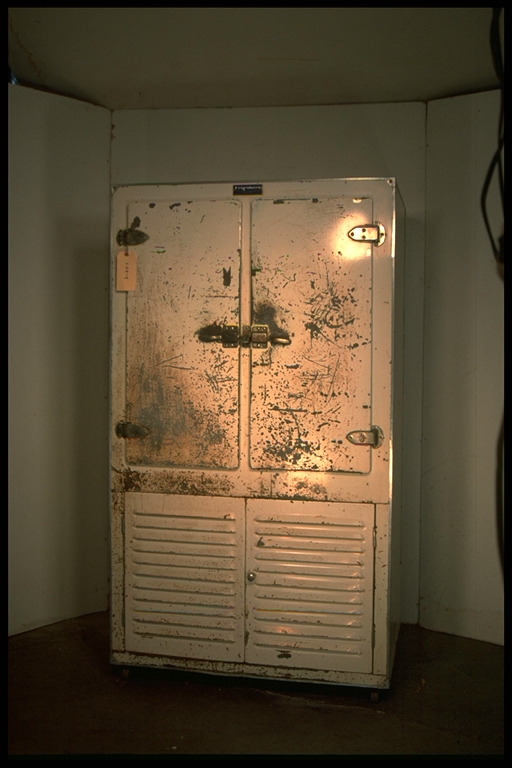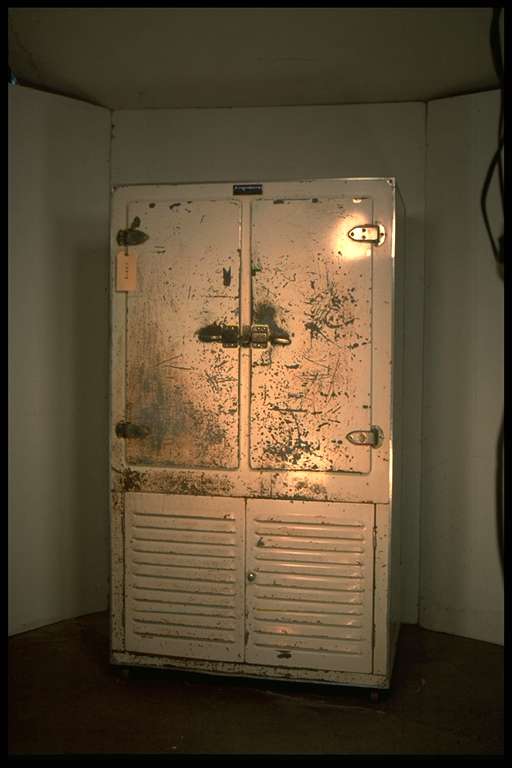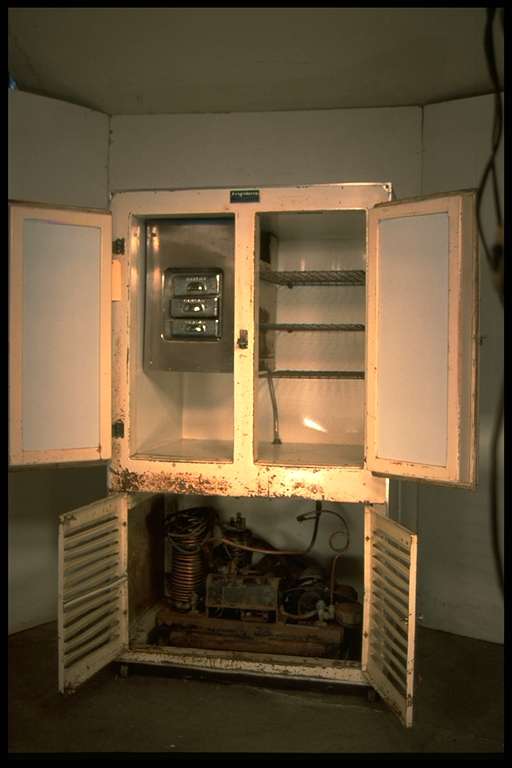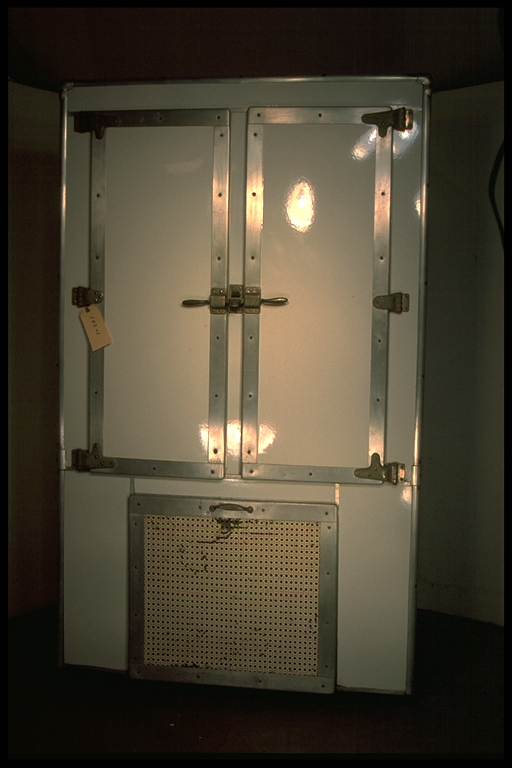1.03-2: Frigidaire 1926 Double Door, Cabinet Refrigerator

| HHCC Accession No. 2003.009 | HHCC Classification Code: 1.03-2 |
|---|
Description:
Nine and One Half Cubic Foot, Double door, Cabinet Refrigerator, Frigidaire, 1926
Group:
1.03 Unitary Refrig and A/C Equipment and Systems - Commercial Refrigerating Equipment
Make:
Frigidaire
Manufacturer:
Frigidaire, Electric Refrigerator, Frigidaire Corp
Model:
Cabinet MP7
Serial No.:
Condensing Unit 569038
Size:
34x 25x 58 1/2 “h
Weight:
375 lbs
Circa:
1926
Rating:
Rare, Demonstration, Education and Research Quality
Patent Date/Number:
Provenance:
From York County (York Region) Ontario, once a rich agricultural hinterlands, attracting early settlement in the last years of the 18th century. Located on the north slopes of the Oak Ridges Moraine, within 20 miles of Toronto, the County would also attract early ex-urban development, to be come a wealthy market place for the emerging household and consumer technologies of the early and mid 20th century. This artifact was discovered in the 1950’s in the used stock of T. H. Oliver, Refrigeration and Electric Sales and Service, Aurora, Ontario, an early worker in the field of agricultural, industrial and consumer technology.
Type and Design:
Unitary design and construction with insulated refrigerated cabinet, evaporator and expansion valve, and self-contained refrigerant condensing unit, electric motor driven. Operating system - compression refrigeration type, theoretical Carnot cycle Self-contained condensing unit with belts driven, 2 cylinder compressor, single-phase electric motor, and air-cooled condenser.
Construction:
Frigidaire cabinet Model MP7, two door refrigerated compartment, with original white Dulux finished exterior, galvanised steel panels, now chipping and worn, applied to heavy wooden cabinet frame with aluminum corner trim strips.
Porcelain steel interior finish, with original tinned wire mesh shelving; wooden framed doors and breaker strips in white Dulux enamel.
Large, self-contained, lower, two door, ventilated machine compartment, Original hardware throughout.
Frigidaire Condensing Unit Serial 569038; twin cylinder compressor Model S, 1 1/4’’ bore x 1 3/4’’ stroke, 350 rpm, 12’’ fly wheel, V belt drive; 1/2’ oval wound, stack, copper tube condenser, for convection air cooling (with non-finned surface);
Low pressure ‘cold control switch’, copper/bronze ‘sylphon’ (bellows), calm operated (See THOC Ref. 2.2, Compressors, P. 23).
11.5 lb. refrigerant receiver for sulphur dioxide; 1/4 HP 25 cycle motor replaced by 60 cycle in 1948 at the time of Hydro conversion in Ontario at which time the machine was still in active service. (See Ref. 2.1, Ch. 1A, P. 3)
Frigidaire low side float, brass, three tray, ice-making, flooded coil evaporator, Model 6, fully shrouded with unique ‘stove pipe’ hole and removable plug on bottom for humidity control. Copper distributing tubes with non-finned surfaces. Tin plated evaporator surfaces with chrome plated front panels and shroud in Dulux coated galvanized steel. Five and a half lb. ice making capacity. Evaporator discontinued by Frigidaire, Dec. 26, 1928. (See THOC Ref. 2.1, Ch 1A)
Material:
The wooden frame construction and metal sheathing panels stand as a fine example of fabrication and construction methods in a period, prior to the advent of more cost effective welded steel frames and sophisticated brake-formed metal panel techniques of the 1930’s. The size and weight of the self-contained, steel framed condensing unit with slow speed, two cylinder compressor and open, belt drive represents the end of a generation of such machines in the kitchens of the Nation. Their weight, size and noise would shortly be all greatly reduced with the introduction of smaller, quieter hermetically sealed refrigeration systems.
The use of noxious refrigerants would also soon disappear, giving the electric refrigerator a greatly improved public image among Canadian householders. The heat transfer surfaces employed here by Frigidaire are unique to the period. For both condenser and evaporator surfaces the manufacturer has not made use of any secondary heat transfer surfaces, neither in the form of plates nor fins.
The results, in both instances, are relatively inefficient extended primary surfaces, which add considerably to the bulk and weight of the refrigerator. The introduction of more efficient heat transfer surface materials and fabrication techniques would shortly contribute to smaller more efficient refrigeration systems for household use.
Special Features:
Accessories:
:
Capacities:
Performance Characteristics:
Operation:
Control and Regulation:
Targeted Market Segment:
The refrigerator stands as an icon of upper class social distinction, tastes and the life styles of the 1920’s in Canada. It was widely promoted in the elite media of the day, targeting the owners of the grand Victorian and Edwardian homes of the period. (See also Item 007 above)
In an advertisement appearing in the April 1926 National Geographic, a maid in full uniform is seen at the fully loaded open refrigerator in a commodious kitchen of the times. Here the promotion was in the form of an appeal to a new modernity, one in which modern kitchen planning became an important sales lever.
Consumer Acceptance:
Merchandising:
Market Price:
Technological Significance:
Unitary Refrigeration Equipment: The idea of a unitary piece of refrigeration or air conditioning equipment was a significant one in its own right, one that had to wait its time. The scientists, engineers and inventors in the early years of the 20th century were intrigued and obsessed with the power of the technology and of its possible market potential. What they saw was the newly discovered principles of physics and heat engines - following, for example, the early works of Carnot, Faraday, Kelvin, and the later work of Perkins, Larsen and Carrier, to name a few.
They understood the promise of the technology for the public good, not to say its consumer sales potential. Early engineering work advanced on a multiple fronts with development of compressors, heat exchangers, valves and piping variously strung together in configurations that would be found to work, but only after much experimentation.
The arrival of unitary equipment, all those parts organised into a single whole, a single unit of construction, a ‘black box’, that could be offered to the consumer market was a significant technological and cultural event. Technologically the refrigerator would need to be seen to be safe, reliable, maintainable and useful. As well, in order to attract the development capital needed, it must be seen as potentially saleable and affordable, contributing to life’s needs and desires. Its socio- cultural and economic significance was marked, for it would change much. As Canadians we would quickly come enjoy potentially healthier lives, expect new levels of comfort and convenience, with a broader, safer, more diverse and enjoyable diet.
As a result, Canadians would quickly come to think of their day differently, for the day would be defined and punctuated in different ways than ever before, as a result of the introduction of modern, electric, household appliances, of which refrigerators, freezers and room air conditioners would be a central part, by the mid 20th century
J. M Larsen produced a manually operated household refrigerator of sorts in 1913, but it was not until 1918 that the Kelvinator Company marketed the first automatic, unitary refrigerator for the home. In that year, it is reported to have sold sixty-seven machines. (See Note 1) The historic artifacts in Group 1.00, Unitary Equipment, including significant samplings the early work of Kelvinator of Canada, provide a rare view of the evolution of unitary refrigeration and air conditioning applications, as they evolved in Canada in the first half of the 20th century.
For those formative years, the artifacts in this Group, 1.00, are typical of the offerings of the Canadian refrigeration and air conditioning industry. They personified the applications found in the homes, farms and commercial premises of the period for, those that could afford life’s new amenities of comfort, convenience and privilege.
This Specimen, along with inventory item No.008 help to profile the significant changes in the industry’s public offerings over a brief 2 years, from 1926 to 1928. The last half of the decade was a period remarkable styling, engineering and manufacturing innovation in the industry, inspired by the rapid market growth of the period. Included, as highlighted in contrasting the two specimens, are styling [square to round, modern corners of the Art deco], finish [yellowing paint to gleaming white porcelain], size and weight of condensing unit.
Industrial Significance:
Socio-economic Significance:
This specimen stands as a cultural icon of upper class social distinction, tastes and the life styles of the 1920’s in Canada. It was widely promoted in the elite media of the day, targeting the owners of the grand Victorian and Edwardian homes of the period. In an advertisement appearing in the April 1926 National Geographic, a maid in full uniform is seen at the fully loaded open refrigerator in a commodious kitchen of the times. Here the promotion was in the form of an appeal to a new modernity, one in which modern kitchen planning became an important sales lever.
Socio-cultural Significance:
Donor:
G. Leslie Oliver, The T. H. Oliver HVACR Collection
HHCC Storage Location:
Tracking:
Bibliographic References:
See THOC Ref. 2.1, Ch. 1A, P. 32 See Frigidaire Manuals


